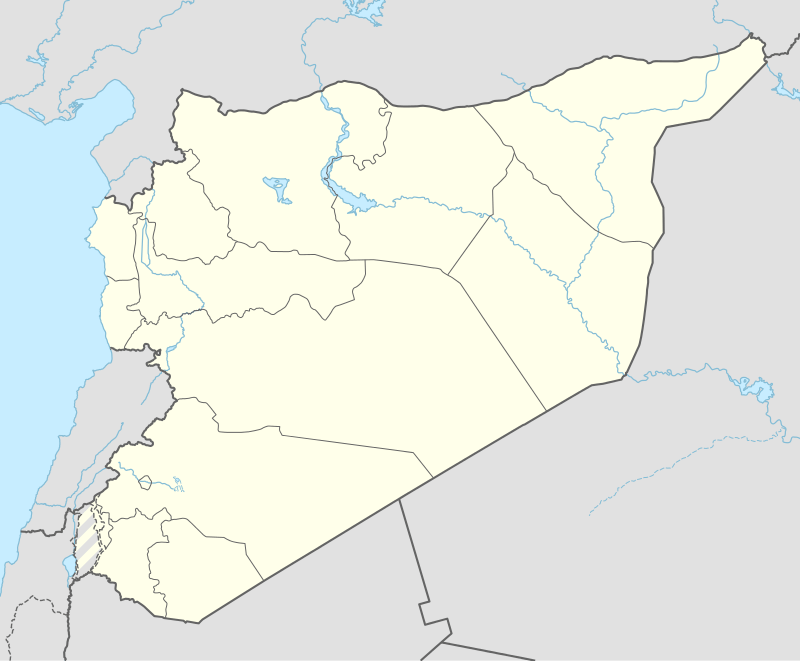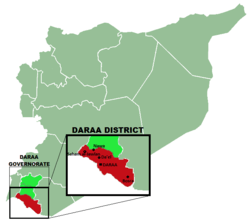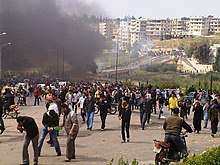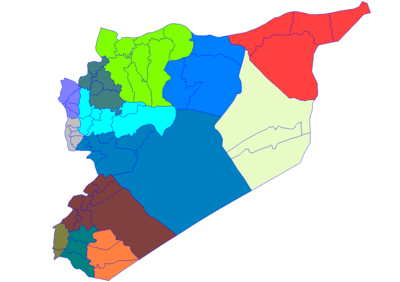Daraa
Daraa (Arabic: درعا, Levantine Arabic: [ˈdarʕa], also Darʿā, Dara’a, Deraa, Dera'a, Dera, Derʿā and Edrei; means "fortress", compare Dura-Europos) is a city in southwestern Syria, located about 13 kilometres (8.1 mi) north of the border with Jordan. It is the capital of Daraa Governorate, historically part of the ancient Hauran region. The city is located about 90 kilometres (56 mi) south of Damascus on the Damascus–Amman highway, and is used as a stopping station for travelers. Nearby localities include Umm al-Mayazen and Nasib to the southeast, Al-Naimah to the east, Ataman to the north, al-Yadudah to the northwest and Ramtha, Jordan to the southwest.
Daraa درعا | |
|---|---|
City | |
 Daraa | |
| Coordinates: 32°37′N 36°6′E | |
| Grid position | 253/224 PAL |
| Country | |
| Governorate | Daraa |
| District | Daraa |
| Subdistrict | Daraa |
| Government | |
| • Governor | Mohammad Khaled al-Hannus[1] |
| Elevation | 435 m (1,427 ft) |
| Population (2004 census)[2] | |
| • City | 97,969 |
| • Metro | 146,481 |
| Demonym(s) | Arabic: درعاوي, romanized: Darʿāwi |
| Time zone | UTC+2 (EET) |
| • Summer (DST) | UTC+3 (EEST) |
| Area code(s) | 15 |
| Geocode | C5993 |
| Website | http://www.esyria.sy/edaraa/ |

According to the Syrian Central Bureau of Statistics, Daraa had a population of 97,969 in the 2004 census. It is the administrative center of a nahiyah ("sub-district") which contains eight localities with a collective population of 146,481 in 2004.[2] Its inhabitants are predominantly Sunni Muslims.[3]
Daraa became known as the "cradle of the revolution"[4] after protests at the arrest of 15 boys from prominent families for painting graffiti with anti-government slogans[5] sparked the beginning of Syrian Uprising of 2011.[6]
History
Ancient history
Daraa is an ancient city dating back to the Canaanites. It was mentioned in Egyptian hieroglyphic tablets at the time of the Pharaoh Thutmose III between 1490 and 1436 BC. It was known in those days as the city of Atharaa. It was later referred to in the Hebrew Bible as "Edrei" or "Edre'i" (אֶדְרֶעִי),[7] the capital of Bashan, site of a battle where the Israelites defeated the city's king, Og.[8] According to Jewish tradition, Eldad and Medad were buried in Edrei.[9]
Classical era
In the Greek Seleucid Empire, of which it was part, and in the Roman Empire into which it was incorporated by Trajan in 106, the city was known as Adraa (Ἀδράα),[10] the name used on its coinage.[11][12] It was incorporated into the province of Arabia Petraea.[13] By the 3rd-century, it gained the status of a polis (self-governed city). Roman historian Eusebius called Adraa a famous city (polis) of Arabia.[8][14] The area east of Adraa was a centre of the Ebionites.[15][16] Adraa itself was a Christian bishopric. Arabio, the first bishop of Adraa whose name is now known, participated in the Council of Seleucia of 359. Uranius was at the First Council of Constantinople in 381; Proclus at the anti-Eutyches synod of Constantinople in 448 and the Council of Chalcedon in 451; and Dorimenius at the Second Council of Constantinople in 553.[17][18] No longer a residential bishopric, Adraa is today listed by the Catholic Church as a titular see.[19] It was also a centre of monastic and missionary activity in the Syrian Desert. In 614, the Sasanian Persians sacked Adraa during the Byzantine–Sasanian War of 602–628, but spared the inhabitants.[13]
Islamic era
Some of the Jewish tribes that Muhammad expelled from Medina settled in Adraa, which in Arabic was called Adra'at.[20] According to Ibn Hisham and al-Waqidi, 9th-century biographers of the Muhammad, the Banu Nadir and Banu Qaynuqa tribes immigrated to Adhri'at following their expulsion from Medina. Historian Moshe Sharon dismisses that assertion however, citing the absence of their claims in any Jewish sources and the earlier Muslim reports.[13] Situated between the major Jewish centres of Palestine and Babylonia, Adhri'at nonetheless had a large Jewish population by the early 7th century and served as a place of Jewish learning. Its residents lit an annual bonfire on Rosh Hashannah in a signal to Babylonia's Jewish communities that the religious new year began.[13]
Early Muslim historian Ahmad al-Baladuri lists Adhri'at as one of the towns that surrendered to the Muslim army following the Battle of Tabuk in 630, while Muhammad was alive. Consequently, the inhabitants paid jizya tax.[21] However, Baladhuri's account was believed to have been a mistake. Instead, contemporary sources maintain that Adhri'at was conquered by the Rashidun army during the caliphate of Abu Bakr in 634.[22] Adhri'at's residents reportedly celebrated the arrival of the second caliph Umar ibn al-Khattab when he visited the city, "dancing with swords and sweet basil."[21] Throughout Rashidun and Umayyad rule, the city served as the capital of the al-Bathaniyya subdistrict, part of the larger Jund Dimashq ("military district of Damascus.")[23]
In 906 the population was massacred in a raid by the rebellious Qarmatians.[21] The late 10th-century Arab geographer al-Muqaddasi noted that during the Abbasid period, Adhri'at was a major administrative center on the edge of the desert.[24] He claimed the city was part of the Jund al-Urdunn district and that its territory was "full of villages" and included the region of Jerash to the south of the Yarmouk River.[24][25]
Throughout the Middle Ages, it served as a strategic station on the hajj caravan route between Damascus and Medina and as the gate to central Syria. The Crusaders briefly conquered Adhri'at, then known as Adratum in the early 12th-century.[26] According to Yaqut al-Hamawi, in the early 13th-century during Ayyubid rule, Adhri'ah was "celebrated for the many learned men who were natives of the place."[24]
Later, under the Mamluks and the Ottomans, the city maintained its importance.[26] In 1596 Daraa appeared in the Ottoman tax registers as Madinat Idra'a and was part of the nahiya of Butayna in the Qada of Hauran. It had an entirely Muslim population consisting of 120 households and 45 bachelors. A 40% tax−rate was levied on wheat, barley, summer crops, goats and/or beehives; a total of 26,500 akçe.[27]
In 1838, Eli Smith listed Der'a as a Muslim, Catholic and Greek Orthodox village in the Nukrah region, south of Eshmiskin.[28]
Modern era
By the 20th-century Adhri'at gained its modern name "Daraa." Following the Ottomans' construction of the Hejaz Railway, it became a chief junction of the railroad. In both his book Seven Pillars and a 1919 letter to a military colleague,[29] T. E. Lawrence describes an episode on 20 November 1917 while reconnoitering Deraa in disguise when he was captured by the Ottoman military, heavily beaten, and sexually abused by the local Bey and his guardsmen.
During the Battle of Megiddo (1918), Lawrence led the Arab Revolt in cutting the southern rail line at Mafraq, the northern at Arar, and the western by Mezerib. [30][31]
Daraa is the southernmost city of Syria on the border with Jordan and a major midpoint between Damascus and Amman[26]
After the Ba'ath Party gained power following the 1963 coup, the new interior minister Amin al-Hafiz appointed Abd al-Rahman al-Khlayfawi as governor of Daraa until 1965.[32] Daraa had recently, before the Syrian Civil War, suffered from reduced water supply in the region, and been straining under the influx of internal refugees who were forced to leave their northeastern lands, due to a drought exacerbated by the government's lack of provision.[33]
Thousands of people protested in the city as part of the 2011 Syrian protests.[34]
Syrian Civil War

The city of Daraa played an important role by the start of the 2011 uprising against the government led by President Bashar al-Assad as part of the Arab Spring protests. The uprising was sparked on the 6th of March 2011, when 15 youths were arrested for scrawling graffiti on their school wall denouncing the Assad regime. The family and friends of the detained youths and many of their supporters marched on the streets on the 15th of March, demanding their release. According to activists, this protest was faced with Syrian security forces opening fire on the protesters killing three people.[35] Protests continued daily. During this time the local courthouse, the Ba'ath party headquarters in the city, and the Syriatel building owned by Rami Makhlouf, a cousin of President Assad, were set on fire. What followed was a government assault on the city as violence continued and intensified all across Syria. On 25 April 2011, the Syrian military launched a large operation in Daraa in a crackdown on pro-democracy protesters.[36] The operation lasted until 5 May 2011. In June 2011, United Nations investigators found that over 240 civilians had been killed.[37]
On 16 February 2012, the Syrian Army reportedly attacked Daraa, shelling the city heavily. This was apparently because, "Daraa has been regaining its role in the uprising. Demonstrations resumed and the FSA provided security for protests in some parts of the city." The attack was part of a security force push "to regain control of areas they lost in recent weeks", indicating that the FSA in Daraa had taken control of parts of the city. Security forces attacked at least three districts, but FSA fighters fought back, firing at Syrian Army roadblocks and buildings housing security police and militiamen.[38] On 14 March 2012, the FSA controlled at least one main district in the city of Daraa (Al-Balad district) which made the Syrian army attack it by firing anti-aircraft guns into buildings of the FSA-controlled district.[39]
In early June 2017, much of the city of Daraa was reported to have been destroyed by protracted fighting.[40]
On 12 July 2018, the battle for Daraa ended after several days of intense clashes between the Syrian Army and rebel forces, some of which agreed to terms of reconciliation. The Syrian Army retook the city fully.[41]
On 1 March, the 2020 Daraa clashes began.
Geography
Climate
Daraa has a cold semi-arid climate (Köppen climate classification BSk).
| Climate data for Dara'a | |||||||||||||
|---|---|---|---|---|---|---|---|---|---|---|---|---|---|
| Month | Jan | Feb | Mar | Apr | May | Jun | Jul | Aug | Sep | Oct | Nov | Dec | Year |
| Average high °C (°F) | 13.3 (55.9) |
14.7 (58.5) |
18.0 (64.4) |
23.6 (74.5) |
28.5 (83.3) |
31.3 (88.3) |
32.6 (90.7) |
32.6 (90.7) |
31.3 (88.3) |
27.8 (82.0) |
21.0 (69.8) |
15.2 (59.4) |
24.2 (75.5) |
| Daily mean °C (°F) | 8.3 (46.9) |
9.4 (48.9) |
12.0 (53.6) |
16.5 (61.7) |
20.5 (68.9) |
23.6 (74.5) |
25.5 (77.9) |
25.6 (78.1) |
23.9 (75.0) |
20.3 (68.5) |
14.4 (57.9) |
9.9 (49.8) |
17.5 (63.5) |
| Average low °C (°F) | 3.2 (37.8) |
4.0 (39.2) |
6.0 (42.8) |
9.3 (48.7) |
12.5 (54.5) |
15.8 (60.4) |
18.3 (64.9) |
18.6 (65.5) |
16.5 (61.7) |
12.8 (55.0) |
7.8 (46.0) |
4.6 (40.3) |
10.8 (51.4) |
| Average precipitation mm (inches) | 60.9 (2.40) |
49.4 (1.94) |
42.3 (1.67) |
15.2 (0.60) |
3.4 (0.13) |
1.0 (0.04) |
0.0 (0.0) |
0.0 (0.0) |
0.4 (0.02) |
9.4 (0.37) |
22.9 (0.90) |
45.9 (1.81) |
250.8 (9.88) |
| Average precipitation days | 10 | 11 | 7 | 4 | 1 | 0 | 0 | 0 | 0 | 2 | 5 | 8 | 48 |
| Source: World Meteorological Organization | |||||||||||||
References
- "Syria protest town 'has new governor'". France 24. 4 April 2011. Archived from the original on 3 May 2011. Retrieved 6 April 2011.
- General Census of Population and Housing 2004 Archived 2012-07-23 at Archive.today. Syria Central Bureau of Statistics (CBS). Daraa Governorate. (in Arabic)
- Sterling, Joe. Daraa: The spark that lit the Syrian flame. CNN. 2012-03-01.
- "Three years later, south Syria's Daraa province locked in stalemate". Syria Direct. Retrieved 2016-02-17.
- "Syria: How it all began". GlobalPost. Retrieved 2016-02-17.
- "Syria: Crimes Against Humanity in Daraa". Human Rights Watch. Retrieved 2016-02-17.
- Numbers 21:33 and Deuteronomy 3:1
- Negev, p. 150.
- Burial Places of the Fathers, published by Yehuda Levi Nahum in book: Ṣohar la-ḥasifat ginzei teiman (Heb. צהר לחשיפת גנזי תימן), Tel-Aviv 1986, p. 253
- William Smith, Dictionary of Greek and Roman Geography (1864): Adraa
- "Catalogue of the Greek coins in The British Museum". google.com.
- "Ancient coins of Arabia". snible.org.
- Sharon, 2007, p. 68
- Fergus Millar, The Roman Near East, 31 B.C.-A.D. 337 (Harvard University Press 1993 ISBN 978-0-67477886-3), p. 419
- Adolf Harnack, The Mission and Expansion of Christianity in the First Three Centuries, Book 4, Chapter 3, section 1
- Albertus Frederik Johannes Klijn, G. J. Reinink, Patristic Evidence for Jewish-Christian Sects (Brill Archive 1973 ISBN 978-9-00403763-2), p. 29
- Michel Lequien, Oriens christianus in quatuor Patriarchatus digestus, Paris 1740, Vol. II, coll. 859-860
- Siméon Vailhé, v. Adraa, in Dictionnaire d'Histoire et de Géographie ecclésiastiques, vol. I, Paris 1909, coll. 592-593
- Annuario Pontificio 2013 (Libreria Editrice Vaticana 2013 ISBN 978-88-209-9070-1), p. 838
- "EDREI - JewishEncyclopedia.com". jewishencyclopedia.com.
- Sharon, 2007, p. 69
- Houtma, 1993, p. 135
- le Strange, 1890, p. 34
- le Strange, 1890, p. 383
- le Strange, 1890, p. 40
- Sharon, 2007, p. 70
- Hütteroth and Abdulfattah, 1977, p. 214.
- Smith; in Robinson and Smith, 1841, vol 3, Second appendix, B, p. 152.
- Letter to W.F. Stirling, Deputy Chief Political Officer, Cairo, 28 June 1919, in Brown, 1988.
- Lawrence, T.E. (1935). Seven Pillars of Wisdom. Garden City: Doubleday, Doran & Company, Inc. pp. 580–583, 635.
- Faulkner, Neil (2016). Lawrence of Arabia's War: The Arabs, the British and the Remaking of the Middle East in WWI. New Haven: Yale University Press. p. 427-429. ISBN 9780300226393.
- Moubayed, 2006, p. 275
- Michael Gunning (26 August 2011). "Background to a Revolution". n+1.
- "Syria to free child prisoners". Al Jazeera. 20 Mar 2011. Retrieved 20 Mar 2011.
- "Middle East unrest: Three killed at protest in Syria". BBC News. 18 March 2011.
- ""We've Never Seen Such Horror" | Human Rights Watch". Hrw.org. 1 June 2011. Retrieved 29 August 2013.
- "Killings continue in Syria as UN reaches "massacre" village". Euronews. 9 June 2012. Retrieved 9 June 2012.
- "Syria live blog Thu, 16 Feb 2012, 06:32". Blogs.aljazeera.net. 16 February 2012. Retrieved 29 August 2013.
- "Syria - Mar 14, 2012 - 11:43 | Al Jazeera Blogs". Blogs.aljazeera.net. 14 March 2012. Retrieved 20 April 2012.
- Syrian regime jets pound Daraa after rebel attacks TheNewArab, 5 June 2017.
- "Breaking: Battle for Daraa city ends in decisive victory for Syrian Army". Al-Masdar News. Retrieved 12 July 2018.
Bibliography
- Houtsma, M.Th. (1993). E.J. Brill's First Encyclopaedia of Islam. 1. BRILL. ISBN 9004097961.
- Hütteroth, Wolf-Dieter; Abdulfattah, Kamal (1977). Historical Geography of Palestine, Transjordan and Southern Syria in the Late 16th Century. Erlanger Geographische Arbeiten, Sonderband 5. Erlangen, Germany: Vorstand der Fränkischen Geographischen Gesellschaft. ISBN 3-920405-41-2.
- Le Strange, G. (1890). Palestine Under the Moslems: A Description of Syria and the Holy Land from A.D. 650 to 1500. Committee of the Palestine Exploration Fund.
- Moubayed, S.M. (2006). Steel and Silk. Cune Press. ISBN 9781885942401.
- Robinson, E.; Smith, E. (1841). Biblical Researches in Palestine, Mount Sinai and Arabia Petraea: A Journal of Travels in the year 1838. 3. Boston: Crocker & Brewster.
- Schumacher, G. (1888). Across the Jordan: being an exploration and survey of part of Hauran and Jaulan. Bentley.
- Sharon, M. (2007). Corpus Inscriptionum Arabicarum Palaestinae, Addendum. BRILL. ISBN 978-90-04-15780-4.
Further reading
- T.E. Lawrence, (various editions) Seven Pillars of Wisdom, Chapter LXXX
External links
- Official Site of Daraa Governorate (in Arabic)
- s:Encyclopaedia Biblica/Ecclesiasticus-Eglon (king)#EDREI
- Map of the town, Google Maps
- Deraa-map; 22L
